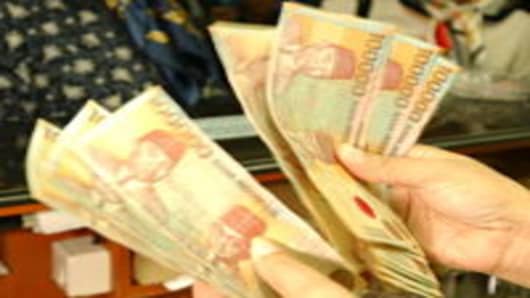Indonesia's economy expanded 6.5 percent in the fourth quarter from a year earlier, as surging domestic consumption and investment offset weakening exports growth, giving the central bank room to hold rates steady this week.
The rise in gross domestic product (GDP) was slightly above the median forecast in a Reuters poll of 6.4 percent. It marked the third straight quarter of 6.5 percent expansion.
The data also showed the economy shrank 1.3 percent from the previous quarter, a slightly smaller contraction than the 1.5 percent forecast.
Full-year 2011 growth was 6.5 percent, the strongest pace since 1996 when the economy expanded 8.0 percent, IMF data shows.
The Indonesian figures show the G20 economy is being shielded from the global slowdown by domestic demand and cap a year during which Indonesia won a return to investment grade status for the first time since the Asian financial crisis.
"Indonesia is one of the least exposed economies in the region, with a vast omestic market and a relatively small share of exports to GDP, so is anyway nsulated from volatility in the global economy," said George Worthington, economist for IFR in Sydney. IFR is a unit of Thomson Reuters.
"In that context, the steady pace of growth and core inflation both argue for similarly steady policy settings from the central bank this week."
Economists expect full-year growth to slow to 6.1 percent in 2012, below a central bank forecast ranging from 6.3 percent to 6.7 percent.
Despite the stronger-than-expected data, Indonesian stocks were down 0.3 percent. The rupiah held steady at 8,890 per dollar after gains this year on fund flows following the sovereign ratings upgrade.
The central bank slashed its policy rate by 75 basis points in October and November to a record low of 6 percent to shield the domestic economy from the chill of the euro area debt crisis. It has kept the rate steady since.
Most Asian countries have reported a slowdown in growth as a slump in the euro zone economy ripples across the global economy.
Growth concerns had fuelled some expectations that Indonesia's central bank might look to cut rates again at a policy review on Thursday.
In addition, government plans to cut fuel subsidies could add to inflation pressures in the months ahead, so it would be easier to justify a rate cut this week while annual inflation is at a 22-month low of 3.65 percent.
However, the GDP figures suggest the economy was resilient and so led some economists to favour a further pause in policy.
"Robust growth undercurrents and a smaller share of external trade to overall GDP signal that the economy is relatively shielded from the vagaries of euro zone uncertainties," said Radhika Rao, an economist at Forecast in Singapore.
"Bank Indonesia is likely to recognize risks of inflationary expectations running amok if growth holds up well this year and thereby draw a pause on the rates front for the time being. We have penciled in 50 bps more cuts this year, though the latter look more probable in H2."
The quarterly contraction came after exports grew an average 9 percent in the fourth quarter, sharply down from growth of about 40 percent in the third quarter. Exports such as coal, coffee and palm oil make up a quarter of the economy.
The last quarter-on-quarter contraction was in the last three months of 2010, when GDP shrank 1.4 percent.
Despite a slowdown in exports growth, domestic consumption and investment grew at a double-digit pace in the fourth quarter. Foreign direct investment (FDI) surged 25 percent, while commercial bank loan growth rose 26 percent in the latest figures for November.
A breakdown of the GDP figures showed that growth accelerated in the hotels, trade and restaurant sector to 10.2 percent from a year earlier . Gross fixed capital formation, a key measure of investment, also picked up to growth of 11.5 percent.
Domestic consumption by the world's fourth-largest population, where an emerging and youthful middle class is snapping up cars and smartphones, makes up over half of the economy.
Retail sales grew an average 27 percent in the fourth quarter, though growth moderated throughout the quarter and retailers now see rising prices because of government plans to lift subsidised fuel costs later this year.
"Looking ahead, we would still be cautious to be too exuberant at this stage," said Gundy Cahyadi, an economist at OCBC Bank in Singapore.
"The recent plunge in export growth is a clear indication that the economy is far from immune from the global economic slowdown and we expect this to remain prevalent in 2012."


